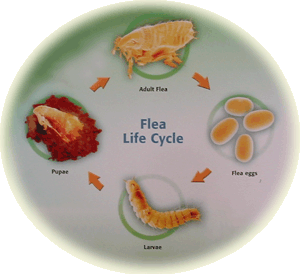Adult fleas are only 5% of the entire flea population. The eggs they lay on the dog fall off into the dog’s environment. Flea eggs are pearly white and too small to see without magnification. They hatch into larvae in 1 to 10 days depending on how humid and hot it is.
Flea larvae eat organic debris and adult flea faeces. They avoid direct sunlight and burrow into carpet fibres, grass, branches, leaves, or soil.
Dry conditions kill larvae. Outdoor larval development occurs where the ground is shaded and moist and where flea-infested pets spend a significant amount of time. Indoors, larvae survive best in the carpet or in cracks in the floor.
 After 5 to 11 days larvae pupate. While in the cocoon pupae are resistant to insecticides and continue to emerge for 3 months despite insecticide application.
After 5 to 11 days larvae pupate. While in the cocoon pupae are resistant to insecticides and continue to emerge for 3 months despite insecticide application.
Pupae emerge as adult fleas in another 5-10 days if stimulated by the vibration of passing pets, physical pressure, carbon dioxide, or heat.
When the adult flea emerges it moves towards body heat, movement, and exhaled carbon dioxide. Following the first blood meal, female fleas begin egg production within 48 hours and continue for 100 days.
This entire life cycle (adult flea – egg – larva – pupa – adult) takes 7 – 21 days depending on temperature and humidity conditions.
Flea control depends on knowing this life cycle.
